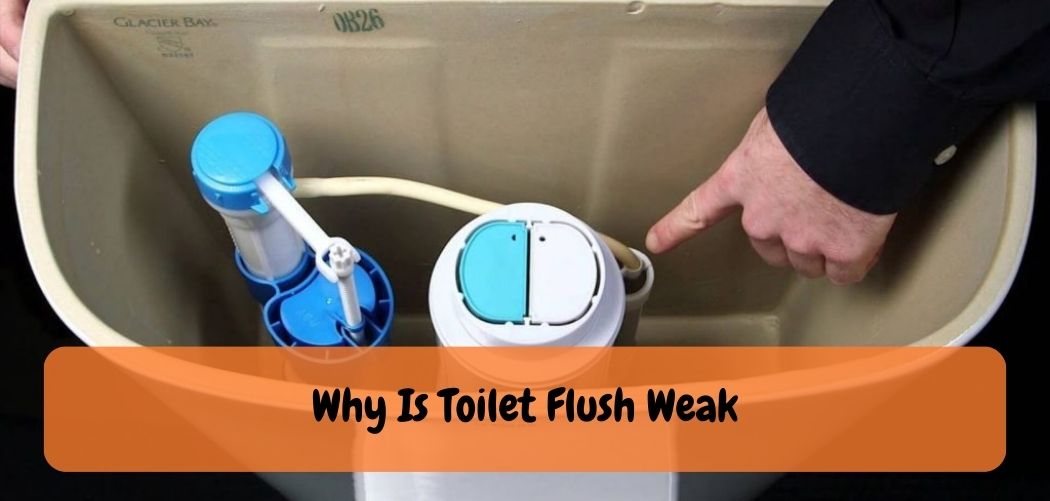Toilet flush can be weak due to a clog or a faulty flapper. A clog will restrict water flow, while a flapper that doesn’t seat correctly will let water escape, reducing flushing power.
A weak toilet flush can be a source of frustration and inconvenience, often leading to incomplete waste removal, repeated flushing, and potential plumbing issues. The question of why a toilet flush is weak encompasses a variety of factors,
Ranging from simple mechanical problems to more complex issues related to water pressure, clogs, or faulty components. Understanding the underlying reasons behind a weak toilet flush is essential for effective troubleshooting and finding the appropriate solutions.
In this discussion, we’ll explore the common causes that contribute to a weak toilet flush and provide insights into how to diagnose and address these issues effectively.
By uncovering the root causes of weak flushes, you can ensure the optimal functionality of your toilet and maintain a hygienic and hassle-free bathroom experience.
Understanding The Causes Of Low Toilet Flush
Toilet flush not flowing as it should? Low water level in the refill tank is often the culprit, resulting in weak flushes. Another cause can be clogs within the trap or pipes, causing water backup. Over time, the flushing mechanism can become damaged, leading to reduced water flow.
Additionally, a faulty flapper valve can limit the amount of water that flows through the toilet bowl, causing weak flushes. If you encounter any of these issues, it’s important to identify and resolve them quickly to avoid further complications.
Check the refill tank and flapper valve for damage, and call a professional if you suspect clogs or other issues in your plumbing system. Understanding these causes can help you maintain a fully operational toilet that flushes with ease.
The Guide: Why Is Your Toilet Flush Weak?
A weak toilet flush can be a frustrating and persistent problem that impacts the efficiency and functionality of your bathroom fixture. Understanding the reasons behind a weak toilet flush is essential for diagnosing and resolving the issue effectively.
In this guide, we’ll delve into common factors that contribute to a weak toilet flush and provide insights on how to troubleshoot and address these problems.
1. Low Water Level in the Tank:
One of the primary reasons for a weak flush is a low water level in the toilet tank. The tank holds the water needed to create the forceful flush that clears waste from the bowl.
If the water level is too low due to a faulty fill valve or improper adjustments, the flush will lack the necessary strength. Check the water level in the tank and ensure it’s adjusted to the manufacturer’s specifications.
2. Clogged Toilet Trap or Drain:
A partial or complete clog in the toilet’s trap or drain can significantly impact flushing performance. When waste or debris obstructs the path of water, the flush becomes weak and ineffective.
Use a plunger or a toilet auger to dislodge the clog and restore proper water flow. If the clog persists, you may need to consult a professional plumber.
3. Faulty Flapper Valve:
The flapper valve is responsible for releasing water from the tank into the bowl during a flush. If the flapper is worn, misaligned, or damaged,
It can result in insufficient water being released, leading to a weak flush. Inspect the flapper for signs of wear and tear, and replace it if necessary to restore proper flushing strength.
4. Mineral Buildup or Sediment:
Over time, mineral buildup and sediment can accumulate in the toilet’s jets, siphon holes, and rim holes. These deposits restrict the flow of water, causing weak flushes.
Regularly clean the jets and holes using a toilet brush, and consider using a toilet bowl cleaner that targets mineral deposits to prevent buildup.
5. Low Water Pressure:
In areas with low water pressure, achieving a strong flush can be challenging. Water pressure plays a vital role in creating the force needed to clear waste effectively. If you suspect low water pressure is the issue, consider consulting your water utility provider to see if there are any solutions or adjustments that can be made.
6. Aging Toilet Components:
As toilets age, their components, such as the flush valve and fill valve, can degrade, leading to weakened flushing performance. Regular maintenance and replacing worn-out parts can help ensure consistent flushing strength.
7. Faulty Fill Valve:
The fill valve is responsible for refilling the toilet tank after a flush. If the fill valve is malfunctioning or not delivering water at the appropriate rate, it can result in a weak flush. Inspect the fill valve for any issues and replace it if needed.
Also Read: Why is Your Toilet Flush Weak?
1. Adjusting The Water Level
Toilet flushes can sometimes be weak due to low water levels. The good news is that adjusting the water level can improve the flow. To do so, locate the water level adjustment screw in the toilet tank. Turning the screw in a clockwise direction should raise the water level.
Once you’ve made the adjustment, test the flush to see if the water flow has improved. It’s a simple fix that can save you from the frustration of dealing with a weak flush.
2. Clearing Clogs
Toilet flush weak? It’s possible you have clogs. Use a plunger to clear blockages. If they’re deeper, employ a plumbing snake. Unclog with baking soda and vinegar mix. Don’t use chemicals. Be careful not to damage your toilet.
3. Repairing Or Replacing Damaged Flushing Mechanisms
To repair or replace damaged flushing mechanisms, disassemble the mechanism carefully. Clean and lubricate the parts to ensure proper functioning. If components are damaged beyond repair, replace them. Weakness in the toilet flush can be a result of various reasons, such as low water pressure, clogged pipes or a malfunctioning flushing mechanism.
It is necessary to identify the root cause and take appropriate actions. In case of a damaged flushing mechanism, it is always better to repair or replace it as soon as possible to avoid any further issues. Regular maintenance of flushing mechanisms can also prevent weak flushes.
It is important to ensure the proper functioning of all components of the toilet system to maintain hygiene and sanitation, making it a comfortable experience for everyone.
Frequently Asked Questions For Why Is Toilet Flush Weak?
What Causes Weak Toilet Flushes?
A weak toilet flush can be caused by an issue with the flush valve, clog, low water pressure, or a malfunctioning flapper valve.
How Can I Increase My Toilet’S Flushing Power?
Increasing your toilet’s flushing power can be achieved by adjusting the water level, cleaning the jets and rim holes, or upgrading the toilet.
How Much Water Should A Toilet Use Per Flush?
Toilets made after 1994 should use no more than 1. 6 gallons per flush. Older toilets may use up to 7 gallons per flush.
What Is The Most Common Cause Of Toilet Clogs?
The most common cause of toilet clogs is flushing items that should not be flushed, such as paper towels, feminine products, and wipes.
Can A Weak Toilet Flush Be Fixed Without A Plumber?
Fixing a weak toilet flush can be done without a plumber by checking for clogs, adjusting the water level, and cleaning the jets and rim holes. Upgrading the toilet may require a plumber.
Conclusion
It is frustrating when your toilet flush is weak, and it doesn’t seem to get the job done. Fortunately, there are several reasons why this might be happening, and there are solutions to fix it. Firstly, you may have a blocked pipeline or a partially blocked suction hole.
Secondly, the flapper valve might not be working properly, or the tank could be too low due to low water pressure. Finally, if your toilet is an older model, it may not have enough flushing power. Whatever the issue may be, it’s wise to get it fixed as soon as possible to avoid water damage and save money on your water bill.
Whether you decide to hire a plumber or try some diy solutions, the result will be a toilet that works efficiently and effectively, providing a stronger flush for years to come.

